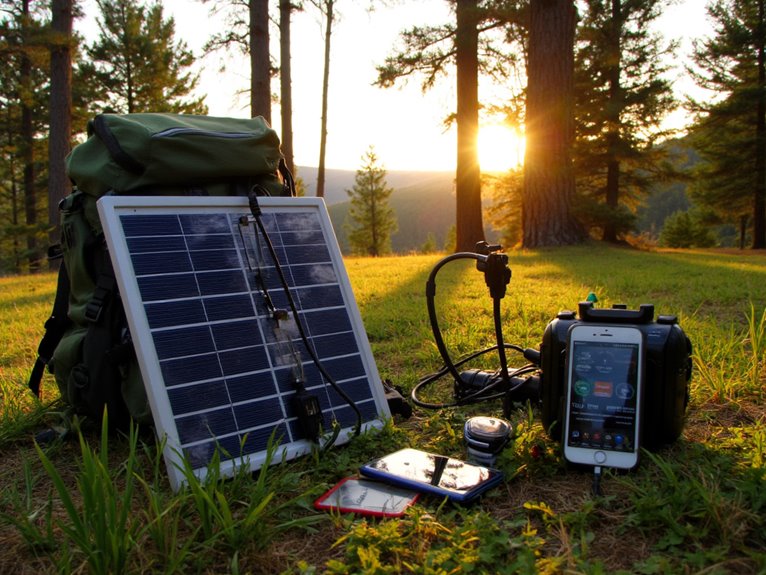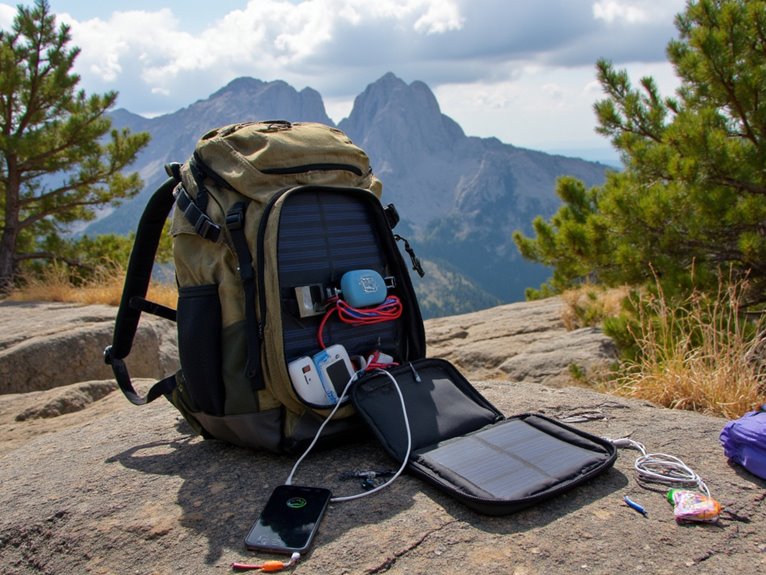Power Management Tips for Outdoor Enthusiasts
You’ll maximize your outdoor power efficiency by selecting portable power stations with 200-1000Wh capacity based on your gear needs, pairing them with monocrystalline solar panels featuring N-Type 16BB cells for superior energy capture. Maintain LiFePO4 batteries by charging to 40-50% before storage, keeping them between 32-68°F, and cleaning terminals monthly with baking soda solution. Integrate smart technology like motion-activated LED lighting to reduce consumption by 75% while using centralized apps for real-time energy monitoring. These foundational strategies reveal advanced optimization techniques.
We are supported by our audience. When you purchase through links on our site, we may earn an affiliate commission, at no extra cost for you. Learn more. Last update on 5th January 2026 / Images from Amazon Product Advertising API.
Notable Insights
- Choose portable power stations based on activity type: compact battery banks (5-10 lbs) for backpacking, larger stations for car camping.
- Pair solar panels with power stations for sustainable charging during daylight hours using monocrystalline cells for maximum efficiency.
- Maintain batteries by charging regularly, cleaning terminals monthly, and storing in cool, dry environments between 60-77°F.
- Use motion-activated LED lighting and smart outlet automation to reduce energy consumption by up to 75%.
- Store equipment properly at 40-50% charge capacity in ventilated areas between 32°F to 68°F to prevent degradation.
Choosing the Right Power Source for Your Outdoor Equipment
When you’re planning an outdoor adventure, selecting the appropriate power source determines whether your essential devices stay operational throughout your trip.
Portable power stations offer the best balance of versatility and reliability. These rechargeable battery packs provide AC, USB, and DC outputs with capacities ranging from 200Wh to over 1000Wh. Power capacity directly impacts how many devices you can charge and for how long.
Weight considerations become critical for backpacking trips. Compact battery banks weighing 5-10 pounds work well for phones and GPS units. Larger power stations exceeding 20 pounds suit car camping where portability isn’t restricted.
Gas generators provide extended runtime but add noise and fuel requirements. For outdoor enthusiasts specifically, models can expand up to 5kWh to handle extended adventures with multiple high-power devices. Many portable power stations can also be recharged through solar panels, adding a sustainable power option during extended outdoor stays. Modern LiFePO4 batteries offer superior durability with over 3500 charge cycles, making them ideal for frequent outdoor use. Match your power source to trip duration, device requirements, and transportation method for ideal results.
Solar Charging Solutions for Remote Adventures
Solar panels transform sunlight into electrical energy, providing an unlimited power source for your outdoor adventures as long as daylight remains available. Different solar panel types offer varying performance levels. Monocrystalline and N-Type 16BB cells deliver superior energy capture compared to standard alternatives.
Solar panels deliver unlimited outdoor power by converting sunlight into electrical energy, with monocrystalline technology providing superior performance for adventures.
Modern solar chargers feature foldable designs and water-resistant construction. Multiple output options including USB and USB-C ports accommodate diverse device requirements. Smart charging technology enhances charging efficiency through automatic power regulation. These portable solutions enable longer exploration and greater outdoor enjoyment. NESTOUT offers both 2-panel and 4-panel configurations to match different power requirements.
- Silent operation eliminates noise pollution unlike gas generators
- Water-resistant panels withstand harsh weather conditions reliably
- Foldable designs maximize portability for backpacking trips
- Multiple outputs charge phones, GPS units, and cameras simultaneously
- Smart technology prevents overcharging while enhancing energy conversion
Position panels facing direct sunlight during peak hours. Clean surfaces regularly to maintain peak energy absorption rates.
Battery Care and Maintenance Best Practices
Capturing solar energy represents only half the power equation for outdoor adventures. Proper battery care directly impacts your power system’s reliability in remote locations. Regular charging prevents capacity degradation and extends battery lifespan considerably.
| Maintenance Task | Frequency | Purpose | Method |
|---|---|---|---|
| Terminal cleaning | Monthly | Prevent corrosion | Wire brush + baking soda solution |
| Connection check | Before trips | Verify secure contact | Tighten all terminals |
| Electrolyte levels | Monthly | Maintain capacity | Add distilled water after charging |
| Equalization charge | Monthly | Balance cells | 2-4 hour controlled charge |
Temperature control remains critical for performance. Store batteries in cool, dry environments between 60-77°F. Electrolyte management requires monthly monitoring for flooded batteries. Add distilled water only after full charging to prevent dilution. Disconnect batteries during extended storage periods to prevent parasitic drain and terminal corrosion.
Smart Technology Integration for Optimal Energy Use

Modern smart technology transforms how you’ll manage power consumption during outdoor adventures, offering unprecedented control over energy distribution and device efficiency.
Smart outlet automation enables programmed on/off schedules that optimize energy use based on your specific needs. Energy monitoring systems provide real-time data analytics to identify peak demand periods and enable strategic load shifting.
- Motion-activated LED lighting reduces energy consumption by up to 75% compared to traditional bulbs
- Battery-powered smart equipment integrates GPS tracking and IoT connectivity for enhanced efficiency
- Centralized mobile apps control multiple outdoor outlets and appliances from a single interface
- Weather-resistant smart outlets deliver reliable power in varied environmental conditions
- Automated scheduling prevents unnecessary device operation during daylight hours
These systems retrofit existing setups without complete overhauls, making advanced power management accessible for any outdoor enthusiast.
Safety Protocols for Outdoor Power Equipment Storage and Handling
While advanced power systems enhance your outdoor adventures, improper storage and handling of equipment can lead to equipment failure, safety hazards, and costly repairs.
Storage safety begins with proper battery maintenance. Charge batteries to 40-50% capacity before storage and store equipment in temperatures between 32°F and 68°F. Clean all equipment thoroughly, removing grass, dirt, and debris to prevent corrosion.
Electrical hazards pose serious risks during storage. Keep power cords unplugged and switches locked off to prevent accidental startups. Never store electrical equipment near water or in wet conditions.
Store equipment indoors in sheds or garages when possible. If outdoor storage is necessary, use heavy-duty tarps for moisture protection. Maintain proper ventilation in storage areas to prevent condensation buildup and material degradation.
On a final note
You’ll maximize your outdoor adventures when you implement these power management strategies effectively. Solar panels rated at 100-200 watts provide reliable charging for most camping scenarios. Lithium-ion batteries maintain 80% capacity after 500 cycles with proper care. Smart charging controllers prevent overcharging damage that reduces battery lifespan by 40%. Always store equipment in weatherproof enclosures and maintain charging cables regularly. These practices guarantee consistent power availability throughout extended wilderness expeditions.

